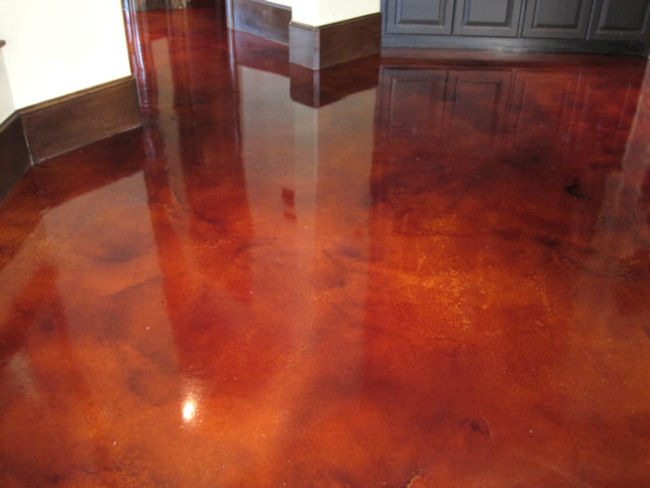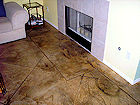Stained Concrete
Tip - throughout our website most smaller images may be enlarged with a click or a tap

Acid and Dye Staining
Acid and dye staining transforms an ordinary concrete slab into a unique and beautifully imperfect floor. No two floors are ever alike because every slab absorbs the color differently. Because the original concrete may have been poured from different batches even if poured at the same time, color differences may be evident from one room to the next – or even from one side of the same room to the other! The stain process will render varying degrees of intensity creating multi-hued color variations that look perfectly aged. Therefore one should expect variability, not uniformity. Staining achieves beauty in an "Old World" imperfect way. (See our photo gallery.)
Without getting too technical, the acid staining process is effected by creating a chemical reaction within the concrete. Acid in the solution opens up the pores of the concrete, and metallic salts, present in the solution, react with lime, an ingredient of cement. Because it actually creates the color in the concrete as opposed to on the concrete, it will not peel and the color is permanent. It may fade or dull slightly, but it is there for the life of the concrete.
As an alternative to acid stain, concrete dyes also provide permanent translucent penetrating color to the concrete. Unlike acid stain, dye does not chemically react with the concrete, and thus color can be more predictable. Dyes sometimes tend to produce a more monotone effect, less of the dramatic effects sometimes found in acid stain.
 Scoring or cutting shallow lines in the concrete, often in a large square or diagonal "tile" pattern, is an attractive option for acid stained floors. Additionally, Surface Systems uses a special saw blade designed for scoring which creates a square groove. This effect is much more attractive than that produced by an ordinary narrow blade, which produces a shallow "V" type of cut.
Scoring or cutting shallow lines in the concrete, often in a large square or diagonal "tile" pattern, is an attractive option for acid stained floors. Additionally, Surface Systems uses a special saw blade designed for scoring which creates a square groove. This effect is much more attractive than that produced by an ordinary narrow blade, which produces a shallow "V" type of cut.
Our acid and dye staining is an intensive process requiring several days to complete.
Once the desired color effects have been achieved, stained surfaces are sealed to enhance the color and to prevent staining of the unwanted kind, e.g. from spills and such. There are pros and cons to the different types of sealers. Solvent based sealers increase the depth and intensity of the color and are fairly glossy. When the application calls for a solvent-based sealer, we suggest using a 100% acrylic ‘breathable’ sealer specially formulated for use on stained concrete.
For a more durable sealer, polyurethane is suggested. We also offer a water based urethane which offers a softer sheen and perhaps a more natural look but with less intensification of the color. However, urethanes are more expensive. Most competitors' bids will contain an acrylic sealer but they are not always the best for the job.
The floor should also be waxed. Wax serves as a sacrificial wear layer to absorb the bulk of the traffic while protecting the sealer underneath, and is easily renewed by simply mopping on another coat.
Please note that all sealers are subject to wear and do need to be reapplied over time, depending on the type originally applied, amount of wear, care, etc. Our professional staff can suggest the proper sealer for your project.
Regardless of your architectural style, when properly done acid staining or dyes blend well into almost any setting. The professionals at Surface Systems stand ready to assist you in creating a beautiful, durable and affordable floor in your home or business!